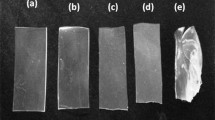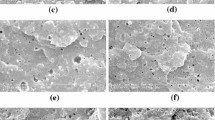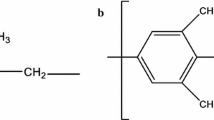Abstract
Thermal stability of solution-cast blends of poly(vinylchloride) and NR-b-PU block copolymers of three different chain extender diols was studied by thermogravimetry. Thermal degradation of individual components and their blends were investigated with special reference to blend ratio. As the block copolymer content in the blends increased their thermal stability was also found to increase. Enhanced thermal stability of PVC is believed due to the favorable interaction with PVC and the PU hard segments of the block copolymer. DTG curves were used for the determination of different stages involved in the degradation. Activation energy for degradation was determined from Coats–Redfern plot.







Similar content being viewed by others
References
Petrovic ZS, Zarargo Z, Flynn JH, MacKnight WJ. Role of functionality in MDI-based elastomer preparation. J Appl Polym Sci. 1994;51:1077–85.
Rajalingam V, Radhakrishnan G, Francis JD. Thermoset polyurethanes from hydroxyl-terminated natural rubber. J Appl Polym Sci. 1991;43:1385–6.
Sung CSP, Schneider NS. Temperature dependence of hydrogen bonding in toluene diisocyanate based polyurethanes. Macromolecules. 1977;10:452–8.
Teo LS, Chen CY, Kuo JF. Fourier transform infrared spectroscopy study on effects of temperature on hydrogen bonding in amine-containing polyurethanes and poly(urethane–urea)s. Macromolecules. 1997;30:1793–7.
Seymour RW, Cooper SL. Thermal analysis of polyurethane block polymers. Macromolecules. 1973;6:48–53.
Shen S, Torkelson JM. Miscibility and phase separation in poly(methyl methacrylate)/poly(vinyl chloride) blends: study of thermodynamics by thermal analysis. Macromolecules. 1992;25:721–8.
Parmer FF, Dickinson LC, Chien JCW, Porter RS. Miscibility of polymethacrylate/poly(vinyl chloride) blends. Macromolecules. 1989;22:1078–83.
Tremblay C, Prud’homme RE. Miscible blends of amorphous polymers. J Polym Sci Polym Phys Edn. 1984;22:1857.
Hamid S, editor. Handbook of polymer degradation. New York: Marcel Dekker; 1992.
Allen G, Bevington J, editors. Comprehensive polymer science, vol 6. Oxford: Pergamon Press; 1989.
Zhu YQ, Huang YJ, Chi ZG. The compatibility of the blends of PUs with PVC and the adhesion behavior of PU to PVC. J Appl Polym Sci. 1995;56(11):1371–9.
Afzal AB, Akhtar MJ, Svensson L-G. Thermal studies of DBSA-doped polyaniline/PVC blends by isothermal microcalorimetry. J Therm Anal Calorim. 2010;100(3):1017–25.
Pielichowski K, Świerz-Motysia B. Influence of polyesterurethane plasticizer on the kinetics of poly(vinyl chloride) decomposition process. J Therm Anal Calorim. 2006;83(1):207–12.
Saraji-Bozorgzad M, Geißler R, Streibel T, Sklorz M, Kaisersberger E, Denner T, Zimmermann R. Hyphenation of a thermobalance to soft single photon ionisation mass spectrometry for evolved gas analysis in thermogravimetry (TG-EGA). J Therm Anal Calorim. 2009;97(2):689–94.
Stankowski M, Kropidłowska Anna, Gazda M, Haponiuk JT. Properties of polyamide 6 and thermoplastic polyurethane blends containing modified montmorillonites. J Therm Anal Calorim. 2008;94(3):817–23.
Bagdi K, Molnár K, Pukánszky B Jr, Pukánszky B. Thermal analysis of the structure of segmented polyurethane elastomers: relation to mechanical properties. J Therm Anal Calorim. 2009;98(3):825–32.
Sobhi H, Ellen Matthews M, Grandy B, Masnovi J, Riga AT. Selecting polymers for medical devices based on thermal analytical methods. J Therm Anal Calorim. 2008;93(2):535–9.
Krongauz VV, Ling MTK. Photo-crosslinked acrylates degradation kinetics. J Therm Anal Calorim. 2009;96(3):715–25.
Kalfoglou NK. Compatible poly(vinyl chloride)/chlorinated polyurethane blends: thermal characteristics. Euro Polym J. 2000;36(1):171–81.
Gopakumar S, Gopinathan Nair MR. Solution properties of NR/PU block copolymers by size-exclusion chromatography and viscometry. J Polym Sci B. 2006;44:2104–11.
Ravindran T, Gopinathan Nair MR, Francis DJ. A novel method for the preparation of hydroxyl terminated liquid natural rubber. Macromol Chem Rapid Commun. 1988;7:159–63.
Radhakrishnan Nair MN, Gopinathan Nair MR. Synthesis and characterisation of soluble block copolymers from NR and TDI based polyurethanes. J Mater Sci. 2008;43:738–47.
Wypych J. Polyvinyl chloride degradation. Amsterdam: Elsevier; 1985.
Coats W, Redfern JP. Kinetic parameters from thermogravimetric data. Nature. 1964;201:68–9.
Satava V. Mechanism and kinetics from non-isothermal TG traces. Thermochim Acta. 1971;2(5):423–8.
Marvel CS, Horning EC. Organic chemistry, vol. 1. 2nd ed. New York: Wiley; 1943.
Hjertberg T, Sorvik EM. Formation of anomalous structures in PVC and their influence on the thermal stability. 2. Branch structures and tertiary chlorine. Polymer. 1983;24:673–83.
Chang EP, Salovey R. Pyrolysis of poly(vinyl chloride). J Polym Sci. 1994;1(2):2927–41.
Carenza M, Moiseev YuV, Palma G. Degradation of poly(vinylchloride). III Kinetics of thermal dehydrochlorination catalyzed by slow-diffusing HCl. J Appl Polym Sci. 1973;17:2685.
Simon P, Valko L. Kinetics of polymer degradation involving the splitting-off of small molecules. Part 6: dehydrochlorination of PVC in an atmosphere of HCl. Polym Degrad Stab. 1992;35:249–53.
Miranda R, Yang J, Roy C, Vasile C. Vacuum pyrolysis of PVC I. Kinetic study. Polym Degrad Stab. 1999;64:127–44.
Miranda R, Rakdel H, Roy C, Darmstadt H, Vasile C. Vacuum pyrolysis of PVC II. Product analysis. Polym Degrad Stab. 1999;66:107–25.
Author information
Authors and Affiliations
Corresponding author
Rights and permissions
About this article
Cite this article
Radhakrishnan Nair, M.N., Gopinathan Nair, M.R. Thermogravimetric analysis of PVC/NR-b-PU blends. J Therm Anal Calorim 103, 863–872 (2011). https://doi.org/10.1007/s10973-010-1113-1
Received:
Accepted:
Published:
Issue Date:
DOI: https://doi.org/10.1007/s10973-010-1113-1




